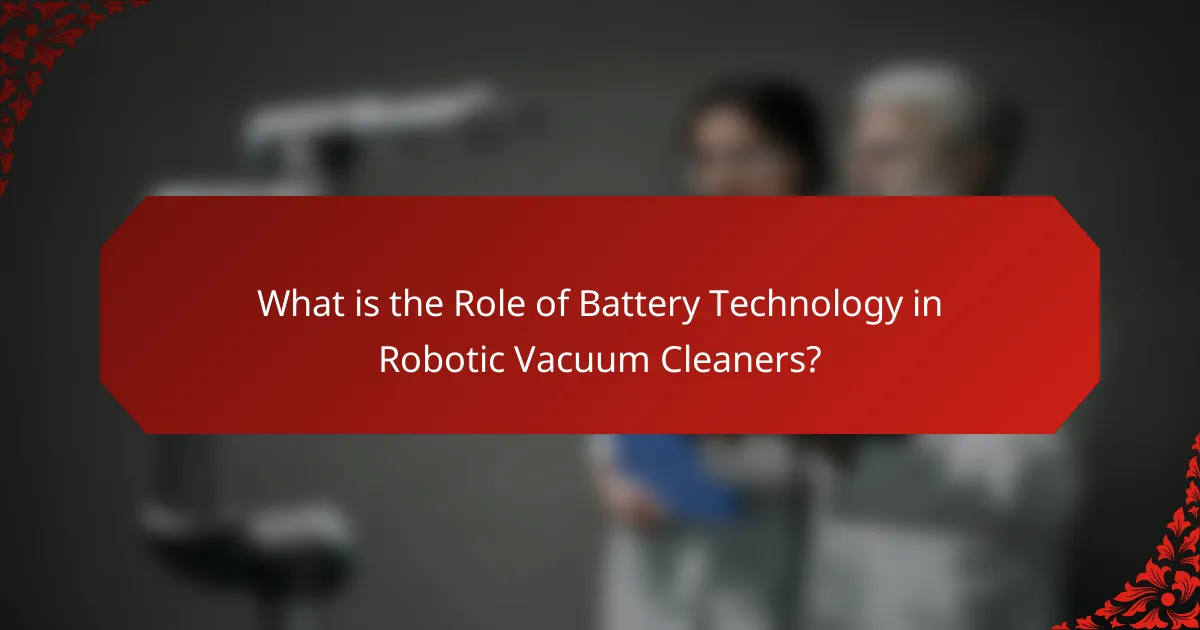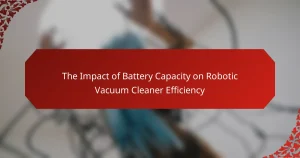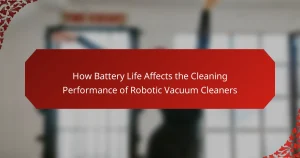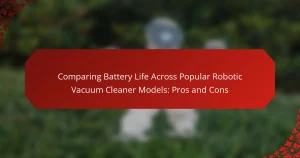Battery technology is essential for the functionality of robotic vacuum cleaners, influencing their mobility and suction capabilities. Advanced battery types, particularly lithium-ion, provide longer run times and faster charging, enabling robotic vacuums to cover larger areas without interruptions. Efficient battery management systems enhance energy utilization during cleaning cycles, while smart features such as scheduling depend on reliable battery performance. As battery technology continues to evolve, improvements in battery life contribute to enhanced cleaning efficiency and increased consumer satisfaction. This article explores the innovations and trends in battery technology and their impact on the operation of robotic vacuum cleaners.

What is the Role of Battery Technology in Robotic Vacuum Cleaners?
Battery technology is crucial for the operation of robotic vacuum cleaners. It provides the necessary power for mobility and suction capabilities. Advanced battery types, such as lithium-ion, offer longer run times and faster charging. These batteries enable robotic vacuums to clean larger areas without interruption. Efficient battery management systems optimize energy use during cleaning cycles. Additionally, smart features like scheduling rely on battery performance. As battery technology evolves, robotic vacuums become more efficient and user-friendly. Enhanced battery life directly improves cleaning effectiveness and consumer satisfaction.
How does battery technology impact the performance of robotic vacuum cleaners?
Battery technology significantly impacts the performance of robotic vacuum cleaners. The type of battery determines the vacuum’s runtime and suction power. Lithium-ion batteries are commonly used due to their efficiency and longer life. They typically provide 60 to 120 minutes of cleaning time on a single charge. This duration allows robotic vacuums to cover larger areas without needing frequent recharges.
In contrast, older nickel-cadmium batteries offer shorter runtimes and less power efficiency. This limits the cleaning performance and operational range of the vacuum. Additionally, battery capacity affects charging time. Advanced battery technology enables faster charging, reducing downtime between cleaning sessions.
Overall, improved battery technology enhances the overall functionality and user experience of robotic vacuum cleaners.
What are the key battery types used in robotic vacuum cleaners?
The key battery types used in robotic vacuum cleaners are lithium-ion and nickel-metal hydride. Lithium-ion batteries are widely favored due to their high energy density and longer lifespan. They typically provide around 300 to 500 charge cycles. Nickel-metal hydride batteries are less common but still used in some models. They offer a lower energy density and shorter lifespan compared to lithium-ion. Lithium-ion batteries enable faster charging and lighter designs. These characteristics enhance the performance and efficiency of robotic vacuum cleaners.
How does battery capacity affect cleaning time and efficiency?
Battery capacity directly influences cleaning time and efficiency in robotic vacuum cleaners. Higher battery capacity allows for longer operational periods before recharging. This extended runtime enables robotic vacuums to cover larger areas in a single cleaning cycle. For example, a vacuum with a 4500 mAh battery can run for up to 120 minutes, compared to 60 minutes for a 2500 mAh battery.
Increased capacity also means that vacuums can maintain consistent suction power throughout their cleaning cycle. This consistency enhances cleaning efficiency by ensuring that dirt and debris are effectively removed. Additionally, larger batteries often support more advanced features, like stronger suction or smart navigation systems, which contribute to a more thorough clean.
Thus, battery capacity is a critical factor in determining both the duration and effectiveness of robotic vacuum cleaners.
Why is battery technology crucial for the evolution of robotic vacuum cleaners?
Battery technology is crucial for the evolution of robotic vacuum cleaners due to its impact on performance and usability. Advanced battery systems enhance the runtime of robotic vacuums, allowing them to clean larger areas without needing frequent recharges. For instance, lithium-ion batteries provide higher energy density compared to older technologies, resulting in longer operational periods. Efficient battery management systems also enable smarter power distribution, optimizing cleaning cycles based on floor type and dirt levels. Furthermore, improvements in charging technology, such as rapid charging capabilities, reduce downtime. According to a report by Markets and Markets, the global robotic vacuum cleaner market is projected to grow significantly, driven by advancements in battery technology. Thus, better battery systems directly correlate with enhanced user experience and increased market growth.
What innovations in battery technology have emerged for robotic vacuum cleaners?
Recent innovations in battery technology for robotic vacuum cleaners include lithium-ion batteries and advanced energy management systems. Lithium-ion batteries provide higher energy density and longer life cycles compared to traditional nickel-cadmium batteries. These batteries allow for extended cleaning times and faster charging capabilities.
Energy management systems enhance battery efficiency by optimizing power usage during operation. Smart features enable robotic vacuums to adapt their power consumption based on the cleaning environment. Some models now incorporate fast-charging technology, reducing downtime significantly.
Additionally, modular battery designs are emerging, allowing users to replace batteries easily. This innovation extends the lifespan of robotic vacuum cleaners and enhances sustainability. These advancements collectively improve the performance and user experience of robotic vacuum cleaners.
How do advancements in battery technology influence design and functionality?
Advancements in battery technology significantly enhance the design and functionality of robotic vacuum cleaners. Improved energy density allows for longer run times without increasing size. This results in slimmer designs that can navigate tighter spaces. Enhanced charging speeds reduce downtime, enabling more efficient cleaning cycles. Advanced battery chemistries, like lithium-ion, provide higher performance and longer life spans. This extends the overall lifespan of the vacuum cleaner. Smart battery management systems optimize power usage, improving cleaning efficiency. Additionally, advancements in safety features prevent overheating and extend battery life. These innovations collectively lead to more effective and user-friendly robotic vacuum cleaners.
What are the current trends in battery technology for robotic vacuum cleaners?
Current trends in battery technology for robotic vacuum cleaners include the use of lithium-ion batteries and advancements in energy density. Lithium-ion batteries are preferred for their lightweight and high efficiency. They typically offer longer run times and quicker charging capabilities. Manufacturers are focusing on increasing energy density to extend operational time without increasing size. Some robotic vacuum cleaners now feature smart battery management systems. These systems optimize charging cycles and prolong battery lifespan. Additionally, there is a trend toward integrating renewable energy solutions, such as solar charging options. This shift aims to enhance sustainability in battery usage for robotic vacuums.
Which manufacturers are leading the charge in battery innovation?
Tesla, Panasonic, LG Chem, Samsung SDI, and CATL are leading manufacturers in battery innovation. Tesla is known for its advancements in lithium-ion technology and energy density. Panasonic collaborates with Tesla to produce high-performance batteries. LG Chem focuses on developing batteries for electric vehicles and consumer electronics. Samsung SDI invests in solid-state battery technology for improved safety and efficiency. CATL is a major player in battery production for electric vehicles and energy storage systems. These companies are at the forefront of enhancing battery performance and sustainability.
What are the environmental implications of battery technology in robotic vacuum cleaners?
Battery technology in robotic vacuum cleaners has significant environmental implications. The production of lithium-ion batteries contributes to resource depletion and pollution. Mining for lithium, cobalt, and nickel can lead to habitat destruction and water contamination. Additionally, battery disposal poses risks if not properly managed. Improper disposal can release toxic substances into the environment. Recycling programs can mitigate some of these impacts. However, the effectiveness of recycling varies by region. Efforts to develop more sustainable battery technologies are ongoing. Innovations aim to reduce reliance on harmful materials and improve recyclability.
How do battery technology innovations enhance user experience with robotic vacuum cleaners?
Battery technology innovations significantly enhance user experience with robotic vacuum cleaners by providing longer run times and faster charging capabilities. Advanced lithium-ion batteries can now deliver up to 90 minutes of continuous cleaning on a single charge. This extended duration allows robotic vacuum cleaners to cover larger areas without interruption.
Moreover, innovations such as quick charge technology enable these devices to recharge in as little as 30 minutes. This feature minimizes downtime and increases convenience for users. Enhanced battery management systems also optimize energy consumption, ensuring efficient operation and prolonging battery life.
Additionally, smart battery features allow users to monitor battery status remotely through mobile apps. This connectivity enhances user control and planning. Overall, these advancements lead to a more efficient and user-friendly cleaning experience.
What features are enabled by advanced battery technology?
Advanced battery technology enables longer run times for robotic vacuum cleaners. These batteries can provide up to 120 minutes of cleaning on a single charge. Enhanced energy density allows for smaller, lighter batteries without sacrificing power. Fast charging capabilities reduce downtime, often charging to full capacity in under two hours. Smart battery management systems optimize energy usage and extend battery lifespan. Safety features such as thermal protection and overcharge prevention are integrated to enhance reliability. Advanced battery technology also supports features like self-recharging, enabling vacuums to return to their dock when low on power. These innovations improve user experience and efficiency in robotic cleaning devices.
How do consumers perceive the importance of battery life in robotic vacuum cleaners?
Consumers perceive battery life as a critical factor in robotic vacuum cleaners. A longer battery life enhances convenience and efficiency during cleaning sessions. Many consumers prefer models that can operate for at least 90 minutes on a single charge. This duration allows the vacuum to cover larger areas without interruption. Additionally, consumers often associate longer battery life with higher overall performance. Research indicates that 70% of users prioritize battery life when selecting a robotic vacuum. This highlights its significance in consumer decision-making. Overall, battery life directly influences user satisfaction and product reliability.
What are the challenges facing battery technology in robotic vacuum cleaners?
Battery technology in robotic vacuum cleaners faces several challenges. One major issue is limited battery life. Most robotic vacuums operate for 60 to 120 minutes on a single charge. This duration often falls short for larger homes. Another challenge is the charging time. Current batteries can take several hours to fully recharge. This delay can hinder operational efficiency.
Battery capacity is also a concern. Higher capacity batteries tend to be bulkier and heavier. This can affect the design and maneuverability of the vacuum cleaner. Additionally, battery degradation over time reduces performance. Lithium-ion batteries, commonly used, can lose capacity after a few hundred charge cycles.
Cost is another significant factor. Advanced battery technologies can increase the overall price of robotic vacuums. Manufacturers must balance performance and affordability. Lastly, environmental impact poses a challenge. Disposal and recycling of batteries raise sustainability issues.
These challenges highlight the need for ongoing innovation in battery technology for robotic vacuum cleaners.
How do cost and availability impact the adoption of new battery technologies?
Cost and availability significantly impact the adoption of new battery technologies. High costs can deter manufacturers from integrating advanced batteries into robotic vacuum cleaners. For instance, lithium-sulfur batteries, while promising, are expensive to produce. Limited availability of raw materials can further restrict supply chains. This scarcity can lead to inflated prices, making it challenging for companies to offer competitive products. Consequently, consumers may opt for established battery technologies that are more affordable. Research shows that battery price reductions of 50% could double electric vehicle adoption rates, indicating a similar trend in robotic vacuum technology. Therefore, both cost and availability are crucial factors influencing the market [censured] of new battery technologies.
What safety concerns are associated with battery technology in robotic vacuum cleaners?
Safety concerns associated with battery technology in robotic vacuum cleaners include fire hazards and battery leakage. Lithium-ion batteries, commonly used in these devices, can overheat and catch fire if damaged or improperly charged. Instances of battery swelling can also occur, leading to potential leaks of hazardous materials. Additionally, poor battery management systems can result in overcharging, increasing the risk of thermal runaway. Regular maintenance and monitoring can help mitigate these risks. Manufacturers often implement safety features, such as temperature sensors, to enhance user safety.
What best practices should users follow to optimize battery life in robotic vacuum cleaners?
To optimize battery life in robotic vacuum cleaners, users should follow several best practices. Regularly clean the vacuum’s brushes and filters to prevent clogs. This ensures efficient operation and reduces battery strain. Schedule cleaning sessions during off-peak hours to avoid interruptions. Utilize the vacuum’s eco mode when available, as it consumes less power. Store the vacuum in a cool, dry place to maintain battery health. Avoid overcharging the battery, as this can shorten its lifespan. Finally, keep the vacuum’s sensors and wheels free from debris to ensure smooth navigation. These practices help prolong the battery life and overall efficiency of robotic vacuum cleaners.
How can proper maintenance prolong battery lifespan?
Proper maintenance can significantly prolong battery lifespan. Regularly cleaning battery terminals prevents corrosion. Keeping batteries at optimal temperatures enhances performance. Avoiding deep discharges helps maintain capacity. Charging batteries before they are fully depleted is beneficial. Using the correct charger ensures proper voltage levels. Following manufacturer guidelines extends battery life. Studies show that proper care can increase battery longevity by up to 30%.
What charging habits can enhance battery performance?
Charging habits that enhance battery performance include avoiding complete discharges and keeping batteries between 20% and 80% charged. Frequent top-ups can help maintain battery health. Using the correct charger for the specific battery type is crucial. Overcharging should be avoided as it can lead to reduced lifespan. Additionally, charging in a cool environment can prevent overheating. Research indicates that lithium-ion batteries last longer when not subjected to extreme temperatures. Following these practices can significantly improve battery longevity and efficiency.
The main entity of this article is battery technology in robotic vacuum cleaners. The article explores the critical role that battery technology plays in enhancing the performance, efficiency, and user experience of robotic vacuums. It covers various battery types, including lithium-ion and nickel-metal hydride, and discusses their impact on runtime, charging time, and overall functionality. Additionally, the article highlights recent innovations, trends, and challenges in battery technology, as well as best practices for optimizing battery life and safety considerations.


